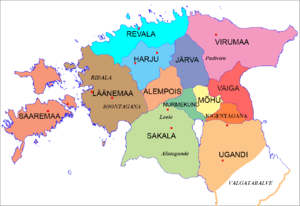Lembitu
| Lembitu | |
|---|---|
| Elder of Sackalia | |
 | |
| Reign | Until September 21, 1217 |
| Successor | Unnepewe, his brother |
| Born | Twelfth century |
| Died |
September 21, 1217 Battle of St. Matthew's Day Near Viljandi |
| Issue | One or several sons |
Lembitu (Estonian also: Lembit, died September 21, 1217) was an ancient Estonian king of Sakala County and military leader in the struggle against conquest of the Estonian lands by the German Livonian Brothers of the Sword at the beginning of the 13th century. He is the only Estonian pre-Crusade ruler, about whom some biographical information is known (he is mentioned only in the Chronicle of Henry of Livonia).[1]
Lembitu, also referred to in Latin as Lambite, Lembito or Lembitus, was first mentioned in chronicles in 1211. Troops led by Lembitu destroyed a troop of missionaries in the historical Estonian county of Sakala and made a raid as far as Pskov, then a town of the Novgorod Republic. In 1215, Lembitu's Lehola (Leal) stronghold (situated near the present town of Suure-Jaani) was taken by Germans and Lembitu was taken prisoner. He was released in 1217.
Lembitu attempted to unite the Estonians in order to withstand the German conquest. He managed to assemble an army of 6,000 Estonian men from different counties, but was killed in the following Battle of St. Matthew's Day in September 1217.[2]
See also
External links
- Lembitu (Estonian)
- Monument of Lembitu in Suure-Jaani (Estonian)
References
- ↑ Miljan, Toivo (2004). Historical Dictionary of Estonia. Scarecrow Press. ISBN 978-0-8108-4904-4.
- ↑ Encyclopædia Britannica. Encyclopædia Britannica, inc. 1970. p. 734.